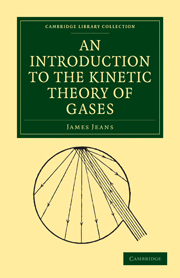Book contents
- Frontmatter
- PREFACE
- Contents
- CHAP. I Introduction
- CHAP. II A Preliminary Survey
- CHAP. III Pressure in a Gas
- CHAP. IV Collisions and Maxwell's Law
- CHAP. V The Free Path in a Gas
- CHAP. VI Viscosity
- CHAP. VII Conduction of Heat
- CHAP. VIII Diffusion
- CHAP. IX General Theory of a Gas not in a Steady State
- CHAP. X General Statistical Mechanics and Thermodynamics
- CHAP. XI Calorimetry and Molecular Structure
- App. I Maxwell's proof of the Law of Distribution of Velocities
- App. II The H-theorem
- App. III The Normal Partition of Energy
- App. IV The Law of Distribution of Coordinates
- App. V Tables for Numerical Calculations
- App. VI Integrals involving Exponentials
- Index of Subjects
- Index of Names
CHAP. I - Introduction
Published online by Cambridge University Press: 07 September 2010
- Frontmatter
- PREFACE
- Contents
- CHAP. I Introduction
- CHAP. II A Preliminary Survey
- CHAP. III Pressure in a Gas
- CHAP. IV Collisions and Maxwell's Law
- CHAP. V The Free Path in a Gas
- CHAP. VI Viscosity
- CHAP. VII Conduction of Heat
- CHAP. VIII Diffusion
- CHAP. IX General Theory of a Gas not in a Steady State
- CHAP. X General Statistical Mechanics and Thermodynamics
- CHAP. XI Calorimetry and Molecular Structure
- App. I Maxwell's proof of the Law of Distribution of Velocities
- App. II The H-theorem
- App. III The Normal Partition of Energy
- App. IV The Law of Distribution of Coordinates
- App. V Tables for Numerical Calculations
- App. VI Integrals involving Exponentials
- Index of Subjects
- Index of Names
Summary
The Origins of the Theory
1. As soon as man began to think of abstract problems at all, it was only natural that speculations as to the nature and ultimate structure of the material world should figure largely in his writings and philosophies.
Among the earliest speculations which have survived are those of Thales of Miletus (about 640-547 B.C.), many of whose ideas may well have been derived from still earlier legends of Egyptian origin. He conjectured that the whole material universe consisted only of water and of substances derived from water by physical transformation. Earth was produced by the condensation of water, and air by its rarefaction, while air when heated became fire. About 500B.C. Heraclitus advanced the alternative view that earth, air, fire and water were not transformable one into the other, but constituted four distinct unalterable “elements”, and that all material substances were composed of these four elements mixed in varying proportions–a sort of dim anticipation of modern chemical theory. At a somewhat later date, Leucippus and Democritus maintained that matter consisted of minute hard particles moving as separate units in empty space, and that there were as many kinds of particles as there are different substances.
Unhappily nothing now remains of the writings of either Democritus or Leucippus; their opinions are known to us only through second-hand accounts. From these we learn that they imagined their particles to be eternal and invisible, and so small that their size could not be diminished; hence the name ἄτιμις–indivisible.
- Type
- Chapter
- Information
- An Introduction to the Kinetic Theory of Gases , pp. 1 - 16Publisher: Cambridge University PressPrint publication year: 2009First published in: 1940

